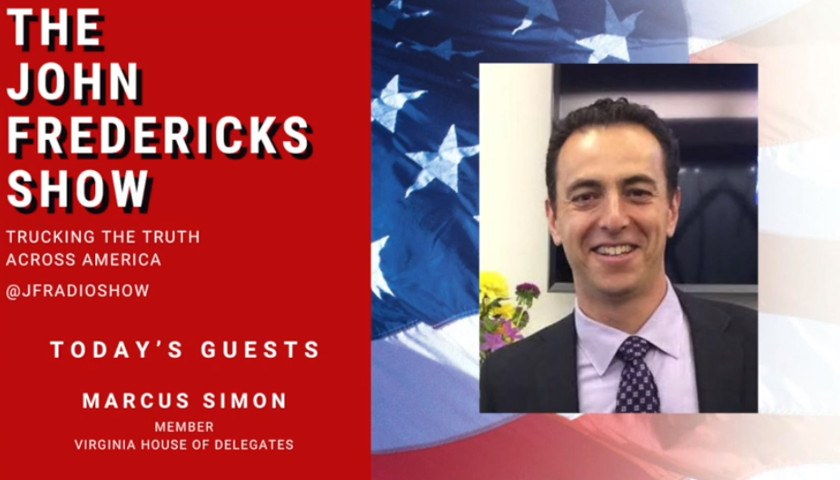Live from Virginia Monday morning on The John Fredericks Show – weekdays on WNTW AM 820/ FM 92.7 – Richmond, WJFN FM 100.5 – Central Virginia, WMPH AM 1010 / FM 100.1 / FM 96.9 (7-9 PM) Hampton Roads, WBRG AM 1050 / FM 105.1 – Lynchburg/Roanoke and Weekdays 6-10 am and 24/7 Stream – host Fredericks welcomed Virginia House of Delegates member Marcus Simon to the show.
During the interview, Simon gave his thoughts on Amendment One which proposes re-districting in Virginia. He added that it was probably something you would not want to vote for because it was an untested, unproven concept and experiment that would become ‘baked’ into the constitution and difficult to remove.
Fredericks: Northern Virginia Marcus Simon. Delegate Simon, it’s been a long time. Great to have you back, man.
Simon: Hey John, it’s great to be with you.
Fredericks: I know, right? Let’s get to this Amendment One. We haven’t really paid attention to it since it finally passed the House and the Senate in the last session. Now it goes on the ballot. But Amendment One is this is a new way to re-district Virginia or sets the district lines. One Virginia. The object is there is about eight people they put together.
Some are politicians and some are regular people. And they draw the lines rather then they say the politicians or legislators themselves. And it did pass the Senate and the House two times straight. Which makes it an amendment. It’s Amendment One on the ballot in Virginia. We had Paul Goldman on the show the other day. He blasted it. He said it was misworded.
He said it was misleading. Now there’s an opposition group saying that this really isn’t a good idea. And I wanted to get your thoughts on it, Marcus Simon. What is the matter with changing the way we draw the district lines in Virginia that get the politicians out of it?
Simon: Well I would be all in favor of changing the way we do re-districting to get the politicians out of it. Unfortunately, that’s not what Amendment One does. In fact, what Amendment One does is it really solidifies the role of politicians. You talked about your eight members.
There are 16 members on the commission. Eight of them are legislators. You got two Republican senators. Two Republican delegates. Two Democratic Senators and two Democratic delegates. And two Democratic Senators. So it’s going to be your most entrenched and most established members that have been around the legislature for awhile.
These are your eight legislative members. And then we get eight citizens right? And there has been a lot of talks that it will be the first time with citizens have a seat at the table. What they don’t talk about is how they pick these citizens. The eight citizen members these regular folks are actually picked from a list provided by, you guessed it, the same people that pick the citizens are the people who are the legislators.
The leaders of the Republican house of delegates. And the two senators and from each party gives a list of acceptable members of the commission which are then picked by a panel of judges? The judges that serve on that panel are also picked by the legislators, right?
If you can get politicians out of this and if you can have a system where you have citizens and professionals, academics, good-government types, and objective people drawing districts that were fair and made sense and reflected Virginia I’d be all for it. In fact, I proposed doing just that at the last session.
But that is not what Amendment One does. And that’s why we are opposed to it. And like you said in the into here, we haven’t talked a lot about it since it passed. So that’s apart of the goal here and the goal here and the mission. We are establishing a group Fair Districts Virginia is to get the word out to folks that this isn’t really what it has been advertised to be. If you really believe in redistricting reform and changing the way we do districts for the better, you should vote no for Amendment One.
Fredericks: A lot of republicans are in favor of this obviously because they don’t like the district changes that were made by I guess the in academician in California. A lot of people thought that those were made specifically to get rid of Chris Jones who had a powerful position. He controlled the money. Tried to get rid of Kirk Goetz who was the Speaker at the time.
A lot of Republicans thought that was kind of a sham for political reasons so they were looking for an alternative. And the Republicans seem to be behind this. But you also have a lot of Democrats behind it. Remember, this thing passed both the House and the Senate with Democratic votes two times straight. Why was it good then but it’s bad now?
Simon: That’s a great question. Just to be clear about who is supporting this. The exact same people that brought you the gerrymandering 2011 maps of their supporters of this amendment. It’s Republicans in the House. And it’s Republican in the Senate. It’s Jack Sockwell and George Barker who are good friends.
I love working with them on a number of important issues who also cut a deal with Bill Howell in 2011 to have everybody to ignore the judiciary commission that Bob McDonnell established and just go back to drawing districts the way they always had and cut House Democrats out of the process.
So that’s how we got our districts in 2011. That is the bi-partisan group of folks that are pushing this amendment. It’s the serial jury members of the General Assembly. And there is a reason they are doing that. They like to have politicians drawing the maps. Now the Republicans that are suspicious and academics and special masters and so forth should be very wary of Amendment One. If you didn’t like the results of our most recent re-districting in 2019 that was done by a special master, you really don’t like amendment one.
Because what happens with this amendment is that any two of the legislative members essentially can veto the commissions’ maps and send it to the Supreme Court to draw maps instead. Of course, the Supreme Court and justices won’t sit there and draw the maps, they’ll do what the court did last time which is to go find a special master or an act of omission from a liberal elite university somewhere to come out and draw the district.
And that’s how we are going to have districts done most likely. I think most people think for better or for worse that this thing is built to fail. It requires a supermajority and requires the cooperation of all the parties that people just don’t think are realistic.
I think most people think we’re going to end up having the Supreme Court draw districts under this Amendment. It won’t be the legislature I guess which is good. If you didn’t like the outcome of the most recent map we’ve drawn then you probably won’t want to vote for Amendment One.
Fredericks: Amendment One is a districting reform that would be baked in the cake in Virginia and part of the constitution for how you come up with how the various state House Delegates and State Senate districts are. So Marcus, let me ask you this.
I saw one poll recently that somebody showed me. And I was a little shocked. Republicans were backing this by 55 percent. Our thought would have been 90 percent because of what happened to them. But it was only 55 percent. Why?
Simon: That’s a great question. Frankly, I think Republicans tend to be a little more skeptical of the so-called reform movements. I think Democrats to your point we’ve have a little more difficulty with our own grassroots because as far as the re-districting of reform it sounds pretty good to people.
We are progressives that want change for the sake of change some times but they don’t look at the details. I suspect that Conservatives as the name suggests are probably a little more skeptical of reform and change for the sake of change without understanding and knowing what the details are. So hopefully as we get closer to the election season starting in the middle of September really people will take a little more critical view of this.
And I think also it’s important if you have doubts about something and if you’re not sure what it does, the idea of baking it into the constitution as you described it, and putting it in there, the constitution is very difficult to change. And once stuff gets in there it’s hard to get it out. To take this untested and unproven concept and experiment how we draw districts and putting it in the constitution. I think probably a lot of people are skeptical about it.
Listen to the full show here:
https://youtu.be/aGmu71CCpTI




